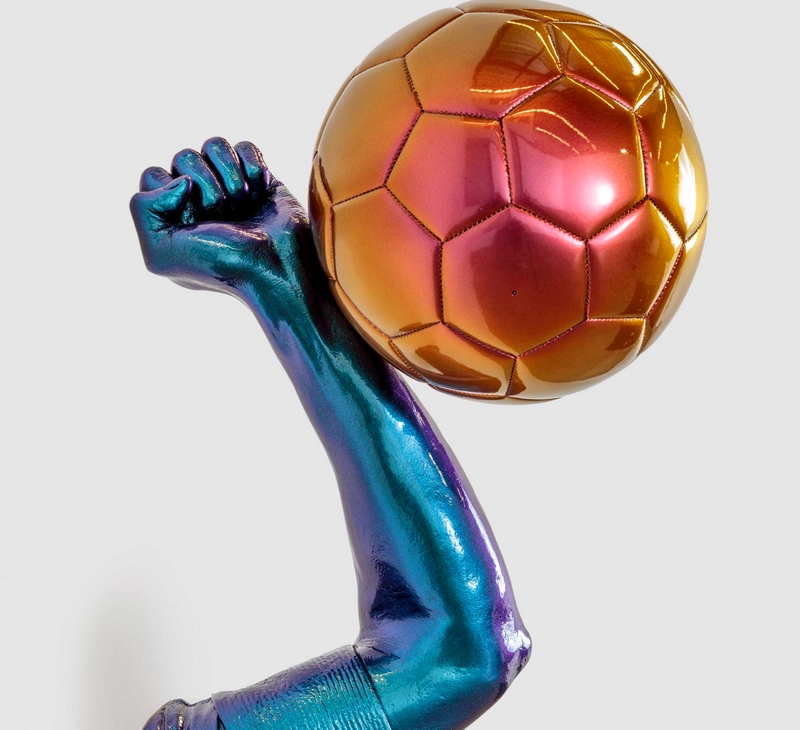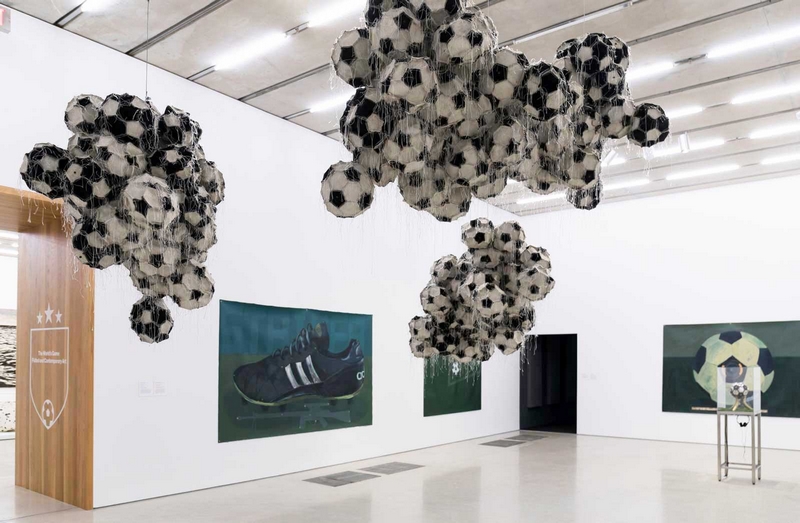“The World’s Game: Fútbol and Contemporary Art” exhibition at the Pérez Art Museum Miami responds to the multilayered aspects of the game of soccer, or fútbol.

Hank Willis Thomas. Hand of God, 2017. Fiberglass, chameleon auto paint finish. Courtesy the artist and Ben Brown Fine Arts, London. © Hank Willis Thomas. Photo: Tom Carter.

Installation viewThe World’s Game Futtbol and Contemporary Art, Perez Art Museum Miami 2018; Photo by Oriol Tarridas
Art and sports aren’t always closely associated – one is more niche, the other intended for the masses. But these cultural opposites are being brought together in a new exhibition that has us thinking about the World Cup beyond the scorecard.
The World’s Game: Fútbol and Contemporary Art, which is on view at the Pérez Art Museum Miami until 2 September, is an exhibition dedicated to the intersection of art and football.
“It comes from the passion for soccer and art,” said the museum’s director, Franklin Sirmans. “Art and sports don’t cross over enough, but it’s a greater phenomenon with more nuances than what we might expect.”
From fan culture to fanaticism, politics, nationalism and sports heroes, the seven-room exhibition features 50 artworks by 40 artists, including Andy Warhol and Kehinde Wiley.
There are deflated soccer balls, red sequin cleats, videos of chaotic stadium crowds and figurines covered in sparkles with artworks from Latin America, the Caribbean and Miami artists. According to the Federation Internationale de Football Association, 240 million people play the game worldwide, which is why it’s dubbed here as the “world’s game”.
“Soccer allows us to come together no matter how much pride we have in our nations,” said Sirmans. “It’s where we can speak across barriers.”

Wiley, who recently gained further exposure after being picked to paint Barack Obama’s presidential portrait, shows a painting of the Cameroonian striker Samuel Eto’o, while Guatemalan artist Darío Escobar shows hundreds of deflated footballs hanging in chandelier-like installations.
The oldest piece in the exhibition is a Warhol portrait of Brazilian soccer champion Pelé. The 1975 portrait impressed the footballer, who said: “He gave continuity to my life and my message outside of the football pitch.”
French-American artist Stephen Dean takes focus off game and on to the fans in a video called Volta, which he shot in a Rio de Janeiro stadium. In following the rhythm of the chanting crowds, this is what the artist describes as a kind of theater, or, “the choreography of euphoria and agony”.
One highlight comes from New York artist Hank Willis Thomas, who shows artwork that questions the “us versus them” sports mentality, not to mention the team worship culture in sports fanaticism. There is one sculpture he is showing of stacked soccer balls called Endless Column III, which is a reference to a famed sculpture by Constantin Brancusi called Endless Column.
“Willis is taking an icon of art history and turning it into this sporting emblem,” said Sirmans. “This is the beauty of what excites me between the intersection of sport and art.”
There is an entire section devoted to sports players as cultural icons, like portraits of Manchester United stars Brian Kidd, George Best and Sir Bobby Charlton by Los Angeles artist Chris Beas, which is what Sirmans calls “showcasing our diversity of our contemporary heroes”.
But is this just a celebration of the male players? It’s certainly stacked with men, and though there are female artists on show – like Mary Ellen Carroll, Maria Lassnig and Priscilla Monge – the female athletes are few and far between. That is, besides the artworks focused on the success of Olympic gold medal-winning American soccer players, Carli Lloyd and Brandi Chastain.
Sirmans acknowledges the scarce mention of female athletes in the show – despite America’s female team winning the World Cup three times in 1991, 1999 and 2015. “We want to change that narrative, as women athletes lead the conversation,” he said. “There is more to come and it’s something we tried to be conscious of.”

The machismo embedded within the game can be found subverted in the work of artist Roberto Guerrero, who has made sequin red soccer cleats, “which are almost like Dorothy’s slippers from the Wizard of Oz”, said Sirmans. “He is looking at how gender is applied to our sporting heroes whether we like it or not, and false ideas around masculinity.”
Some other critically charged artworks are meant to reflect on the stifling nature of football; as some say the game has recently been called a rich, white kid sport, or how losing a game can be a blow for national shame, like in South Korea, where team players are punished with military enrollment. Some say that politics and sports cannot be separated.
“Games have been used in times of oppressive dictatorship, it can be used as a form of propaganda as well,” said Sirmans. “What does it really mean for the people?”
One video artwork shows how sports culture can represent larger battles, like the border wall Donald Trump wants to build along Mexico. The video is called Rules of the Game, and is by Mexican artist Gustavo Artigas, who has filmed two pairs of American and Mexican football and basketball teams simultaneously play against each other on the same court.
“The video was an experiment to see how these teams play while bumping into each other, but still find a way to focus and play,” said Sirmans. “It’s a metaphor of how we can continue to live together and how absurd the idea of a border wall between nations might be.”
- The World’s Game: Fútbol and Contemporary Art is on show at the Pérez Art Museum Miami until 2 September
guardian.co.uk © Guardian News & Media Limited 2010
Published via the Guardian News Feed plugin for WordPress.

